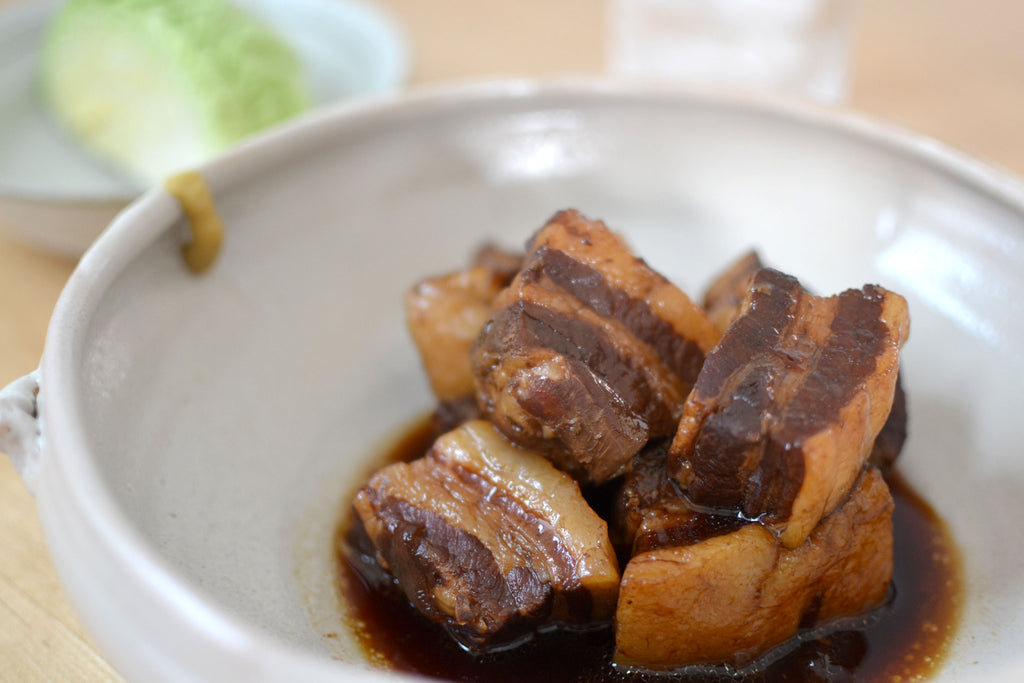 With the fires and virus raging, I spent all last weekend in my kitchen with the windows shut tight and the air filter blasting. Making this Pork Belly Kakuni recipe from our friends at The Japanese Pantry was the perfect weekend project. Kakuni means simmered cubes, which refers to the shape of the pork belly chunks. Aromas of star anise, black vinegar, and kokuto sugar wafted through the house with no where to go. Who cares if my couch and blankets still smell like pork belly – it's divine.
With the fires and virus raging, I spent all last weekend in my kitchen with the windows shut tight and the air filter blasting. Making this Pork Belly Kakuni recipe from our friends at The Japanese Pantry was the perfect weekend project. Kakuni means simmered cubes, which refers to the shape of the pork belly chunks. Aromas of star anise, black vinegar, and kokuto sugar wafted through the house with no where to go. Who cares if my couch and blankets still smell like pork belly – it's divine.
One of the surprising things about this recipe is how easy it is to make it. I would file this under Kayoko's popular recipe column Lazyass Cookin'. There's very little chopping and it's all cooked in one pot and simmered on a low setting for an hour to 90 min.
I'd say that mustard and a side of greens are mandatory with this dish. Both the mustard and greens will play off the rich fattiness of the pork belly. I simply served the dish with a wedge of raw cabbage to enjoy between bites of pork. It cleanses the palette and provides a contrasting texture. Pork Belly Kakuni is also commonly served with steamed spinach (steamed kale will do as well).

INGREDIENTS
3 lb pork belly cut into 2 inch cubes
0.5 cup regular soy sauce, like Higeta
0.5 cup Yugeta double-brewed soy sauce
3 oz black vinegar, like Kurosu Rinkosan Uchibori
1.75 cup water
3 oz sake
0.5 cup kokuto sugar
0.5 oz dried shiitake (approximately 6-8)
1 onion, roughly chopped
2 in ginger, sliced in 0.25 inch coins
1 star anise
5 whole garlic cloves

METHOD
1. Cut pork belly in 2 inch cubes.

2. Combine all other ingredients in a pot and stir on medium-high heat until the sugar melts.

3. Add the pork belly cubes into the pot and bring to a simmer.


Add an otoshibuta (drop lid), onto the pot and dial back the heat to low.

4. Check for doneness in one hour by poking it with a toothpick. It should slide right in. If not, check back every 10-15 minutes. I ended up cooking mine for 90 minutes total.

5. Remove the pork pieces onto a plate to rest. Skim fat off the liquid.

6. Return the pork pieces to the pot.

And you are now ready to serve, here with a wedge of raw cabbage and a glass of kokuto shochu on-the-rocks.

I have to admit right here that I'd never made this dish before, and upon first taste, I was pretty blown away by how rich this tasted despite the minimal labor involved. This recipe combines the satisfying tang of black vinegar mingling with the mineral-richness of the kokuto sugar, absorbed into melt-in-your-mouth cubes of pork belly. With this dish alone, one could open a solid izakaya. Just add a few sakes and shochus on the menu and you are in business!
This is a great dish to save for later too. It actually tastes better the day after because all of the flavors will have even more time to synergize. And with 3 pounds of pork belly, you'll likely have leftovers (if not, I'm not judging). So not only does this qualify as Lazyass Cookin', it also yields lunch for the next day, and provides the weeklong scent of star anise and pork belly in the kitchen when you can't open your windows.




Comments (0)
There are no comments for this article. Be the first one to leave a message!